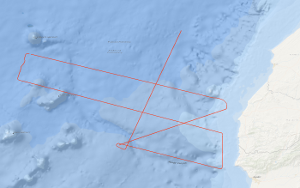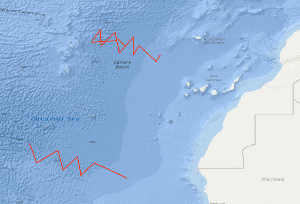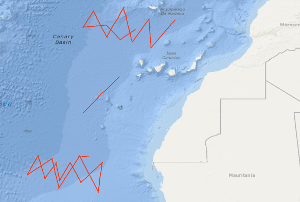Keyword
Westafrika
140 record(s)
Provided by
Type of resources
Available actions
Topics
Keywords
Contact for the resource
Service types
-

From 1st May to 25th May 2011 the French Institute from Brest Institut Français de Recherche pour l'Exploitation de la Mer (IFREMER) together with BGR conducted a scientific cruise on the IFREMER research vessel L'ATALANTE, which constitutes the 1st leg of the MIRROR survey. In order to acquire supplementary marine geophysical research data to the MIRROR scientific survey a 2nd leg was performed from 2nd June to 11th June 2011. Both legs are spread over the shelf edge and slope of Morocco, the adjacent Essaouira Rise, and the easternmost abyssal plain, and are located between 33°30' N and 30°30' N. The region of MIRROR Leg 2 is situated south of Leg 1. The main research objectives were to image the deep structure of the crust, to test the origin of the magnetic anomaly S1, and to test rifting models in order to understand the nature of the continental margin of Morocco as well as the opening history of the Atlantic Ocean. Another objective was to realize a comprehensive sediment basin analysis for specifying the hydrocarbon potential of the region. In total multi-channel seismic lines with a length of 1,391 km and additional 271 km with the other geophysical methods (magnetic field measurements as well as bathymetry) were acquired. The seismic data acquired during Leg 2 were processed onboard and two of the lines were interpreted. Line BGR11-208 traverses from DSDP Site 415 to Site 416 and ties the MCS grids of both MIRROR legs as well as other former MSC surveys of BGR. Therefore, the line enables a reliable regional seismostratigraphic interpretation and a moderately well mapping of the Jurassic, Cretaceous, and Cenozoic sequences. Large compressional structures are present in the sedimentary cover along the seismic line pointing to transform faults or an activated fracture zone. Regarding the NWW-SEE trending line BGR11-202 the area of investigation can be subdivided into three structural units, a zone of rifted continental margin, a zone of initial seafloor spreading, and a zone of regular seafloor spreading as well as post-Cretaceous igneous activity. Huge rotated basement blocks are located under the shelf and uppermost slope and striking salt domes at the lowermost slope. The zone of initial seafloor spreading is characterized by a sub-basement reflector with overlying tilted basement blocks. The sub-basement reflector trends generally horizontal and appears to be a detachment fault. The magnetic slope anomaly S1 is located at foot of the slope near the western boundary of the zone of rifted continental margin.
-

The BGR 1991 cruise with M.V. BIN HAI 511 was designed to study the variability of the oceanic crustal structure along flow-line profiles perpendicular to the ridge axis over Early Tertiary through Cretaceous old oceanic crust of the eastern Atlantic Ocean. Seismic data with a coverage of 3,000 % were acquired along four flow-line profiles with a total length of 4,194 km, and in addition 270 km of MCS data were collected during the period from 2nd October to the 3rd November 1991. The most intriguing new observation from the seismic flow-line profiles is the discovery of two huge oceanic crustal structures characterized by an internally divergent to planar pattern of reflectors having ubiquitous seaward dip. These remarkable structures were found within an about 1,300 km long oceanic crust segment of the eastern South Atlantic located between the Bode Verde Fracture zone in the north and the Rio Grande Fracture Zone in the south. These structures resemble the prominent wedges of seaward dipping reflectors on the widespread volcanic rifted continental margins described in the literature. They are interpreted to represent voluminous build-ups of layered extrusive rocks formed during three excessive episodes of volcanism that accompanied the Cretaceous opening of the South Atlantic. These episodes of excessive volcanism/magmatism are: An episode immediate prior to, and during the first stage of seafloor spreading in the South Atlantic, i.e. during about Hauterivian through about early Aptian; an episode of inferred subaerial and/or shallow marine volcanism along the central South Atlantic spreading ridge during the Albian; and an episode of inferred subaerial and/or shallow marine volcanism along the South Atlantic spreading ridge during latest Cenomanian/earliest Turonian through early Campanian.
-

In continuation of a fracture zone survey of BGR in 1985, there was a multichannel seismic survey of the Hayes Fracture Zone between 20°W and 27°W in the time from October 26th to November 11th, 1988. In spite of bad weather conditions, it was possible to collect a total of 1.760 km seismic and gravity data on 11 lines. From a first interpretation of the seismic monitor records on board it appears that the frequency of intra-crustal reflections in the records from the area west of 20°W is much less than on the records of the survey of the previous cruise in 1985. During a second leg in the time period from 14th November to 21th November 1988 an additional seismic survey of the Kane Fracture Zone took place with 7 supplementary profiles.
-

A geophysical reconnaissance survey across oceanic fracture zones has been carried out by the BGR in the eastern North Atlantic using S.V. PROSPEKTA. The geophysical measurements, including multichannel seismic reflection profiling, magnetics and gravity were concentrated on three oceanic crustal areas of Mesozoic crust which are crossed by the Hayes Fracture Zone, the Atlantis Fracture Zone and the Kane Fracture Zone respectively. 24 geophysical lines with a total length of 5,362 km have been measured during the time period from 25th October to 4th December 1985. Besides intracrustal seismic events a deep coherent seismic event is often recognizable in the monitor records between 10 - 12 s (TWT) along several lines, which probably is a reflection from the crust-mantle boundary.
-

Durchschnittsalter der Schutzsuchenden: Bundesländer,Stichtag, Geschlecht, Ländergruppierungen/Staatsangehörigkeit
-

Durchschnittliche Aufenthaltsdauer der Schutzsuchenden:Bundesländer, Stichtag, Geschlecht, Ländergruppierungen/Staatsangehörigkeit
-

Durchschnittliche Aufenthaltsdauer der Schutzsuchenden:Bundesländer, Stichtag, Geschlecht, Ländergruppierungen/Staatsangehörigkeit
-

Ausländer: Deutschland, Stichtag, Geschlecht,Aufenthaltstitel/Ausgewählte Aufenthaltstitel,Ländergruppierungen/Staatsangehörigkeit
-

Ausländer: Deutschland, Stichtag, Geschlecht, Familienstand,Ländergruppierungen/Staatsangehörigkeit
-

Schutzsuchende: Deutschland, Stichtag, Geschlecht,Aufenthaltsdauer/Aufenthaltsdauer (AbgrenzungEinbürgerungen), Ländergruppierungen/Staatsangehörigkeit
 www.geodatenkatalog.de (S3L)
www.geodatenkatalog.de (S3L)